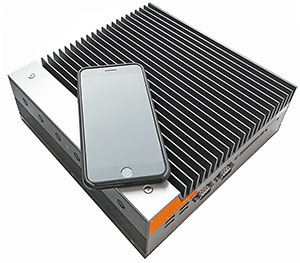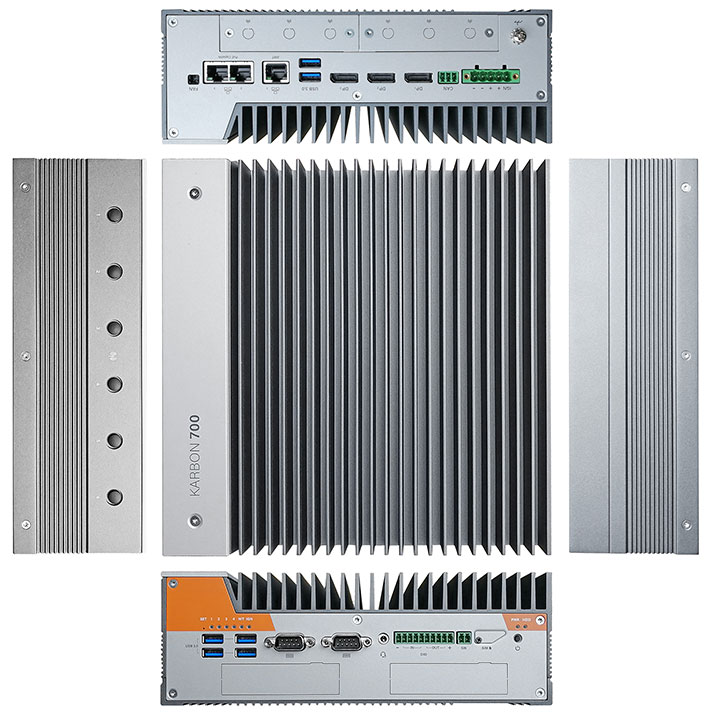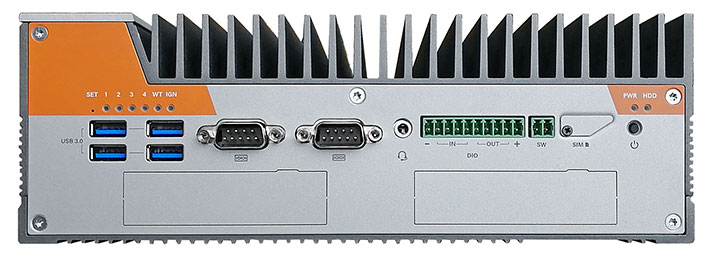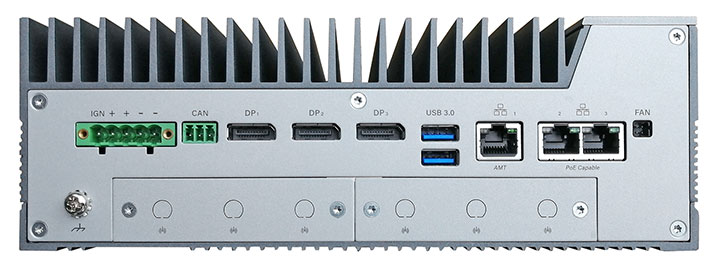|
OnLogic Karbon 700
Highly configurable, high-performance rugged box computer brings power, reliability, and connectivity to industrial edge deployments
(by Conrad H. Blickenstorfer)
When it comes to rugged computing gear, most people interested in this industry know the big players that dominate the market and get all the media coverage. But that's not everything there is. Unbeknownst to many outside of the circle of customers and prospects, a surprising number of smaller companies are designing, manufacturing and distributing rugged computing systems of one type or another. One such company is OnLogic (formerly known as Logic Supply) located in South Burlington, a small town in the northwestern part of Vermont. OnLogic makes and distributes a variety of rugged/embedded industrial systems and components both under partner brands and their own brand.

For a hardware manufacturer, OnLogic is unusually enthusiastic about their products. Most people don't consider industrial and embedded systems particularly exciting, but the folks at OnLogic love to talk about their "designed to be redesigned" philosophy, about "mass customization" (using standardized screws, paints, sheet metal folds, and design concepts to keep the cost low), "upgrade kits" as a cost-effective way to cover popular customization options, and their belief in "innovation, not invention!" i.e., adding value to things that work well rather than spending much time trying to re-invent the wheel.
Not your father's global industrial PC company
As a result, we've been reviewing OnLogic industrial computing gear on and off. And were always impressed by their quality, packaging, informational materials, and meticulously produced comprehensive manuals.  So despite our tightly filled schedule we didn't pass an opportunity to take a look at their new Karbon 700 high performance rugged Box PC. So despite our tightly filled schedule we didn't pass an opportunity to take a look at their new Karbon 700 high performance rugged Box PC.
Generally, the first thing you notice with most things from OnLogic is that they really like the color orange. Heck, even their company brochure concludes with a heart-felt "The Future Looks Brighter in Orange."
A look at OnLogic's website suggests the company truly is quite fond of the color. This doesn't mean all of their products are orange, but most of their industrial grade embedded PCs are, and that certainly makes for an interesting visual change from the black and gray that bedecks the vast majority of industrial computing gear.
The OnLogic Karbon 700 webpage boldly proclaims the the new machine as "high-performance rugged computing, evolved." But what is the Karbon 700? Like most industrial PCs it's not that large, measuring a bit less than 10 x 10 inches and about three inches tall. The image to the left shows the unit with an iPhone 7 Plus sitting on it.
What is the Karbon 700 made for? Pointing at its resistance to extreme temperatures, airborne contaminants and shock or vibration forces, OnLogic sees the Karbon 700 handling high-performance IoT edge computing in heavy industrial, in-vehicle, railway and remote applications.
IoT edge computing
What's IoT edge computing? IoT — the "Internet of Things" — is one of those not too terribly terrific terms that describes a silent, hidden revolution that the population at large is barely aware of, and surprising number of insiders aren't either. IoT describes a world of internet communication that is no longer limited to people or machines communicating with each other. In the IoT, "things" communicate as well. "Things" may be vehicles, cameras, doors, cars, refrigerators, entire homes, sub systems, or entire homes or factories — anything that can measure something and pass that data on for processing and feedback. The total market for all of this combined is gargantuan.
The term "edge computing" refers to a distributed computing framework that, in an effort to cut down response times and save bandwidth, brings computing resources and data storage as close to the place where it is actually needed as possible.
 "The Edge continues to expand further out from the data center, placing increasingly challenging environmental demands on hardware," says Johnny Chen, Solutions Architect at OnLogic. "Engineers and Project Managers creating solutions that require both significant computing power and extreme durability are frequently faced with tough decisions in trying to balance cost, features, performance, and reliability. We created Karbon 700 to address these challenges and bring tremendous power to the edge, without sacrificing features or durability." "The Edge continues to expand further out from the data center, placing increasingly challenging environmental demands on hardware," says Johnny Chen, Solutions Architect at OnLogic. "Engineers and Project Managers creating solutions that require both significant computing power and extreme durability are frequently faced with tough decisions in trying to balance cost, features, performance, and reliability. We created Karbon 700 to address these challenges and bring tremendous power to the edge, without sacrificing features or durability."
"No two IoT deployments are the same, says Maxx Garrison, OnLogic Product Manager in charge of the company's Rugged product line. And so OnLogic decided to build a machine that not only sports all the customary I/O common to all industrial PCs, but they also added their own proprietary "ModBay" interface that enables flexible expandability to meet specific application requirements.
So let's take a closer look at the Karbon 700.
Steel and aluminum (and a splash of orange)
The image below shows the Karbon 700 from the top and all four sides. The device consists of steel front and back plates (and more steel inside) with cutouts for the various ports, and large, prominent finned aluminum heat sinks/spreaders. There is no fan; heat is conducted away from the Karbon 700's CPU and other electronics to the large metal heat sinks via heat-conducting material and then dissipated to the air. There may be exceptions for some of the hotter-running CPU options available, but our review unit had no problems with its 35 watt TDP processor.

The Karbon 700, like most compact industrial PCs, is a simple and straight-forward design, a precision-engineered piece of computing machinery of very high quality. The design is rational down to the smallest detail. Compact and integrated enough to make for a fairly compact package, but large enough to easily accommodate a good number of industry-standard PC ports and modules. Do note, though, that while the Karbon 700 doesn't have a fan or ventilation slots, it is not a sealed unit (and doesn't claim to be).
The picture below shows the system from the front:

As is the case with many industrial and panel PCs, the Karbon 700's I/O is in the back and in the front and nowhere else. That's because the unit is designed to be either sitting flat or mounted on a wall, so that large finned heat sink is freely exposed to cooling air. Our review Karbon 700 provided the following external ports on the front:
- 4 x USB 3.1
- 2 x RS232/422/485 serial
- 1 x 3.5mm audio speaker/microphone
- 1 x 8-bit Isolated Digital I/O
- 1 x Remote switch
- 1 x Mini-SIM slot
- Power button
- 2 x cutouts for optional 2-1/2 inch SATA drive bays

Unlike most industrial and panel PCs where I/O is either in the back or facing down, the Karbon 700 has edge-mounted I/O on three sides — top, front and back. That's because the unit is designed to sit upright, with its two large finned heat sinks freely exposed to cooling air. Our review Karbon 700 provided the following external ports:
The next picture shows the system from the rear:
- Power input with automotive ignition sensing
- 1 x CAN Bus
- 3 x DisplayPort, allowing three independent displays
- 2 x USB 3.1
- 1 x RJ45 GBE LAN jack
- 2 x RJ45 GBE LAN jacks with optional PoE (Power over Ethernet)
- Connector for optional external fan
- 6 x Antenna cutouts
Due to the widely varying requirements of industrial customers, OnLogic also offers a range of special connectors, adapters, and cables. These include terminal block connectors for power, a remote switch, CAN bus, and DIO, as well as a 5-pin terminal block to 6-pin Molex adapter and SATA power and data cables.
A peek inside
 Needless to say, we opened up the Karbon 700 to see how it's built and what it looks like inside. Needless to say, we opened up the Karbon 700 to see how it's built and what it looks like inside.
The housing consists, as is usually the case with such industrial Box PCs, of steel plates and massive aluminum heat sinks with prominent finning. Open a few Torx 10 screws, and one of the Karbon 700 easily comes apart off, opening access to the top of the 8-1/2 x 9-1/4 inch motherboard.
The challenge in this type of design is thermal management. With no fan there is no active airflow, and so heat generated by components must be dissipated through the aluminum heatsinks.
That is best done by facilitating direct contact, and OnLogic does that by liberally applying thermal pads and blocks that conduct heat from hot components to the heatsinks. Those thermal soft thermal pads can easily rip and tear. OnLogic often ships a products with a couple of thermal pad kits, just in case.
Why would one open a Karbon 700? Mostly to gain access to the system's expansion slots. In our unit, a 512GB Transcend PCIe NVMe storage module took up one of the M.2 PCIe slots. The additional four slots — two M.2 and two mPCIe — can be used for WiFi, mobile broadband or whatever other expansion and functionality is desired. There are two SO-DIMM RAM slots. The Karbon 700 also has no fewer than six(!) cutouts for external antenna connectors.
But even that is not all. The Karbon 700 also has two "ModBay" expansion connectors. One can accommodate four optional RJ45 LAN or PoE jacks, the other yet four more RJ45 LAN jacks. There's further a PCIe riser that can accommodate adapters for either a single x16 card or for two x8 cards. Available PCI expansion includes USB, LAN/PoE (yes, more yet), or a selection of no fewer than six Nvidia GPUs.
OnLogic says that every component has been thermally optimized to provide reliable wide operating temperature operation, and the chassis is thermally designed to perform in whatever situation it finds itself in, from deserts to glaciers. Below a couple of thermal imaging views of the Karbon 700 while running a benchmark suite, taken with our FLIR One Pro camera.

Ruggedness
From a ruggedness standpoint, industrial Box PCs such as the Karbon 700 may encounter temperatures extremes, shock/vibration, and airborne particulates. Since they are not carried around, the drop spec and IP rating (sealing against solids and liquids) that in part define the durability of mobile devices are essentially irrelevant. Shock and vibration resistance, however, are not, and those have been tested to IEC 60068- 2-27 and IEC 60068-2-64 procedures. The operating temperature range can be as wide as -40°F to 158°F, depending on processor and cooling method (there's an optional external fan) chosen.
Overall, OnLogic sought to comply with all pertaining MIL-STD-810G, UNECE Reg. 10 E-Mark, and EN50155 rolling stock standards to ensure stable and reliable performance of the unit. That also included fanless design, medical-grade ESD and interference protection, solid-state components as well as wide 9-48VDC input voltage support.
Performance
When OnLogic approached RuggedPCReview about hands-on with the upcoming Karbon 700 they inquired as to what configuration we'd like to test. We asked them to send us the fastest, meanest, no-holds barred configuration possible, and that's pretty much what they did. The octa-core/hexadeca-thread Intel Xeon E-2278GEL is officially part of the Intel 9th generation "Coffee Lake-Refresh" family and was just introduced early summer 2019.
Unlike many workstation-class Xeon processors that draw considerable power, the Xeon E-2278GEL makes do with a TDP (Thermal Deign Power) of just 35 watts. That's more than the maximum of 15 watts that's common in rugged mobile laptops and tablets today, but in the overall sceme of things, 35 watts doesn't present a challenging thermal load and thus is quite suitable for fanless operation.
To provide an idea of the relative performance of the so-equipped Karbon 700, we ran our two standard benchmark suites, PassMark (both versions 6.1 and 9.0) and CrystalMark. For comparison, we're also listing the results of the much smaller Karbon 300 we recently tested, as well as a high-powered ARBOR industrial PC we tested last year and, for comparison, a small Celeron-based Winmate IPC.
|
Mini-PC/IoT Gateway Systems Benchmarks and Comparisons
|
|
PERFORMANCE COMPARISON
|
OnLogic
|
OnLogic
|
Arbor
|
Winmate
|
|
Model
|
Karbon 700
|
Karbon 300
|
FPC-8002
|
EACIL67
|
|
Model (click pic for review)
|

|

|

|

|
|
Year tested
|
2019
|
2019
|
2018
|
2019
|
|
Intel processor
|
Xeon E-2278GEL
|
Atom E3950
|
Core i7-7700T
|
Celeron N3350
|
|
Cores/threads
|
8/16
|
4/4
|
4/8
|
2/2
|
|
CPU base speed
|
2.00GHz
|
1.60GHz
|
2.90GHz
|
1.10GHz
|
|
CPU turbo speed
|
3.90GHz
|
2.00GHz
|
3.8GHz
|
2.40GHz
|
|
Thermal Design Power (TDP)
|
35.0 watts
|
12.0 watts
|
35.0 watts
|
6.0 watts
|
|
PassMark 6.1
|
5,629.7
|
1,347.9
|
3,456.8
|
NA
|
|
PassMark 9.0
|
3,904.2
|
1,030.6
|
3,041.0
|
901.1
|
|
Overall CrystalMark
|
406,787
|
143,195
|
274,715
|
103,533
|
The results show three things:
- First, the 9th gen octa-core Xeon E-2278GEL equipped OnLogic Karbon 700 provides thundering, devastating performance, overall by far the highest of any system we've ever tested. For a fanless industrial PC that's quite an accomplishment, and it shows how careful selection of state-of-the-art high-performance components can really shine. Heck, our test Karbon 700 even absolutely blasted through all those annoying Windows updates that usually take forever.
- Second, as fast as the Xeon E-2278GEL is, it's not even the fastest chip OnLogic offers for the karbon 700. That would be the Xeon E-2176G that powers through the PassMark CPUMark test another 11% faster, albeit at a much higher 80 watt Thermal Design Power.
- And third, OnLogic's very wide range of CPU options shows once again how important it is to spec industrial PCs not on lowest price, but on getting the exact right processor for the job. That may be the lowest-end chip or it may be one of the high-end chips.
To help with that decision, peruse the table below. It shows all the different processors available for the Karbon 700 (for full Intel spec table, click here).
|
OnLogic Karbon 700 processor options
|
|
PROCESSOR OPTIONS
|
Xeon
|
Celeron
|
Pentium
|
Core i3
|
Core i5
|
Xeon
|
Core i7
|
Xeon
|
|
Model
|
E-2278GEL
|
G4900T
|
G5400T
|
8100T
|
8500T
|
E-2124G
|
8700T
|
E-2176G
|
|
Cores/Threads
|
8/16
|
2/2
|
2/4
|
4/4
|
6/6
|
4/4
|
6/12
|
6/12
|
|
Base Clock Speed
|
2.00 GHz
|
2.90 GHz
|
3.10 GHz
|
3.10 GHz
|
2.10 GHz
|
3.40 GHz
|
2.40 GHz
|
3.70 GHz
|
|
Turbo Speed
|
3.90 GHz
|
No turbo
|
No turbo
|
No turbo
|
3.50 GHz
|
4.50 GHz
|
4.00 GHz
|
4.70 GHz
|
|
Cache
|
16MB SmartCache
|
2MB SmartCache
|
4MB SmartCache
|
6MB SmartCache
|
9MB SmartCache
|
8MB SmartCache
|
12MB SmartCache
|
12MB SmartCache
|
|
Thermal Design Power (TDP)
|
35 watts
|
35 watts
|
35 watts
|
35 watts
|
35 watts
|
71 watts
|
35 watts
|
80 watts
|
|
Graphics base speed
|
350 MHz
|
350 MHz
|
350 MHz
|
350 MHz
|
350 MHz
|
350 MHz
|
350 MHz
|
350 MHz
|
|
Graphics max speed
|
1.20 GHz
|
1.00 GHz
|
1.05 GHz
|
1.10 GHz
|
1.10 GHz
|
1.15 GHz
|
1.20 GHz
|
1.20 GHz
|
|
Intel vPro
|
Yes
|
No
|
No
|
No
|
Yes
|
Yes
|
Yes
|
Yes
|
|
Intel TSX-NI
|
Yes
|
No
|
No
|
No
|
Yes
|
Yes
|
Yes
|
Yes
|
|
Intel SIPP
|
Yes
|
No
|
No
|
No
|
Yes
|
Unknown
|
Yes
|
Unknown
|
|
Intel Trusted Execution
|
Yes
|
No
|
No
|
No
|
Yes
|
Yes
|
Yes
|
Yes
|
|
Relative CPU Cost
|
11.80
|
1.00
|
1.52
|
2,78
|
4.57
|
5.07
|
7.21
|
8.62
|
What may make a difference in certain applications is the availability of four special Intel technologies (vPro, TSX-NI, SIPP, and Trusted Execution) included in some of the available processors but not in others. Here's what that means:
The extra security and manageability capabilities of vPro, especially, are required in many enterprise deployments.
- TSX-NI (Transactional Synchronization Extensions New Instructions) helps make parallel operations more efficient via improved control of locks in software,
- SIPP (Stable Image Platform Program) allows deployment of standardized, stable image PC platforms for at least 15 months, and
- Trusted Execution technology provides security capabilities such as measured launch and protected execution, and may thus also be an enterprise requirement.
As far as "relative CPU" cost goes, it means that while Intel charges its customers 1X dollars for the low-end processors available for the Karbon 700, it charges almost 12 times as much for the highest-end processors. This, of course, has an impact on overall system cost.
Faster storage
On the mass storage side, OnLogic's Karbon 700 is ahead of much of the competition. That's because it makes available PCIe NVMe instead of, or in addition to, older, slower SATA-based storage technology. To explain the advantage of that we must backtrack a little. For decades, hard disks served as mass storage almost exclusively. Hard disks are complex mechanical devices with rotating platters and fragile read heads. Wear and tear is an issue with hard disks, as are disk crashes due to vibration or impact. For that reason, hard disks were increasingly replaced by faster and less vulnerable SSDs — solid state drives — in many (and now most) applications.
However, even SSDs have their bottlenecks. In terms of performance, for some time now that bottleneck has been the SATA interface between the storage module and the computer. SATA's been around for a decade and a half and data transmission speed has pretty much maxed out.
The PCIe standard, on the other hand, can reach throughput speeds up to several times higher, depending on which PCIe standard is used and how many "lanes" are available. And PCIe doesn't even require major changes. The standard M.2 connector supports both SATA and PCIe, and PCIe storage modules are the same "gumstick" size as SATA storage modules.
In rugged mobile computers, PCIe's adoption has been slow, despite all of its advantages. It's much to OnLogic's credit that they made the switch. The pay-off is considerably faster "disk" performance.
As is, OnLogic let's you configure the Karbon 700 with either SATA or PCIe NVMe storage up to 1TB. SATA storage is also available in wide temperature versions. Two 2-1/2-inch drives can be installed either internally or in externally accessible hot-swap bays. If installed, 2.5-inch drives can be configured as RAID 0 (striping for superior performance) or RAID 1 (mirroring for redundancy).
The Karbon 700-X2 PCIe option
In addition to the basic Karbon 700 (which they call the K700-SE model), OnLogic also offers an extended version that adds standard PCIe expansion. The Karbon 700-X2 supports standard PCIe expansion, providing either a PCIe x16 slot or two PCIe x8 slots.
 The expanded Karbon 700-X2 essentially adds another box underneath the standard Karbon 700, adding a bit over two inches in height. PCIe expansion provides access to additional I/O and functionality that's best handled via add-on cards. The expanded Karbon 700-X2 essentially adds another box underneath the standard Karbon 700, adding a bit over two inches in height. PCIe expansion provides access to additional I/O and functionality that's best handled via add-on cards.
OnLogic itself offers about a dozen PCIe expansion cards that add a variety of LAN and PoE cards as well as half a dozen different Nvidia graphics cards.
PCI stands for "Peripheral Component Interconnect," a local bus standard specification created by Intel in the early 1990s as a replacement for older ISA, EISA, MCA and VLB standards. PCIe — PCI Express — came in 2004 as a faster version of PCI and an alternate/replacement for a number of other standards.
The Karbon 700 by OnLogic
A lot of companies make industrial box PCs, machines that usually benefit from their designers' experience in embedded systems technology and meeting the requirements of demanding industrial/government/vertical market customers. The industrial PC market is mature and, by its very nature, not terribly exciting. We're talking unheralded workhorse technology here.
And that's why it is gratifying to see smaller companies such as OnLogic go the extra mile with attention to design and detail, a splash of color here and there, and offering technology choices and options that aren't just good enough, but state-of-the-art.
The Karbon 700 by OnLogic was created to bring power, reliability, and connectivity to industrial edge deployments, and it certainly does that. Thanks to its exceptional versatility, configurability and scalability, however, its application potential is essentially unlimited
-- Conrad H. Blickenstorfer, November 2019
OnLogic Karbon 700 Specs:
| Status |
Added and reviewed 11/2019
|
| Type |
High-performance rugged industrial edge computer
|
| CPU Type |
Celeron G4900T: 2 cores/2 threads
Pentium G5400T: 2 cores/4 threads
Core i3-8100T: 4 cores/4 threads
Core i5-8500T: 6 cores/6 threads
Xeon E-2124G: 4 cores/4 threads
Core i7-8700T: 6 cores/12 threads
Xeon E-2176G: 6 cores/12 threads
|
| CPU speed |
Celeron G4900T: 2.90GHz
Pentium G5400T: 3.10GHz
Core i3-8100T: 3.10GHz
Core i5-8500T: 2.10GHz, 3.50GHz max turbo frequency
Xeon E-2124G: 3.40GHz, 4.50GHz burst frequency
Core i7-8700T: 2.40GHz, 4.00GHz burst frequency
Xeon E-2176G: 3.70GHz, 4.70GHz burst frequency
|
| Graphics |
Celeron G4900T: Intel® UHD Graphics 610
Pentium G5400T: Intel® UHD Graphics 610
Core i3-8100T: Intel® UHD Graphics 630
Core i5-8500T: Intel® UHD Graphics 630
Xeon E-2124G: Intel® UHD Graphics P630
Core i7-8700T: Intel® UHD Graphics 630
Xeon E-2176G: Intel® UHD Graphics P630
|
| OS |
Windows 10 Home/Pro/IoT Enterprise, Ubuntu
|
| Memory |
4GB to 16GB LPDDR4 (eide temp, ECC available as option where supported)
|
| Watchdog Timer |
Unknown |
| Graphics Interface |
2 x DisplayPort
|
| LAN |
3 x GbE LAN (2 of them optionally PoE), Intel I210IT GbE LAN controller |
| Expansion |
1 x mPCIe, 1 x mPCIe/mSATA, 1 x M.2 2230, 1 x M.2 2230/60/80, 1 x M.2 2280, 1 x PCIe riser
|
| Primary Storage |
32GB to 1TB M.2 Sata SSD (wide temp optional), 128GB to 1TB M.2 NVMe SSD
|
| Additional Storage |
128GB to 1TB M.2 NVMe SSD, up to two 2.5-inch SATA 32GB to 1TB SSD (wide temp optional) or 1T to 4TB ATA hard disk
|
| Housing |
Steel case with finned aluminum heatsinks, wall-mount
|
| Vibration |
Tested according to MIL-STD-810G, Method 514.6, Category 4, Common Carrier over US Highways 1 hour per axis, 3 axes
|
| Shock |
Tested according to MIL-STD-810G, Method 516.6 for Ground Level Equipment 40g, 11ms, sawtooth, 3 pulses positive and negative per axis, 3-axis, operating
|
| Humidity |
10% ~ 95%
|
| Regulatory |
2011/65/EU (RoHS 2 Directive)
Additional Safety and EMC certifications pending, CE, EN 55024, EN 55032, EN 62368-1, FCC 47 CFR Part 15, IEC 60068-2-27, IEC 60068-2-64
|
| Operating temperature |
-40°F to 104 to 158°F (-40°C to 40 to 70°C), depending on processor TDP and cooling
|
| USB |
6 x USB 3.1 gen 1
|
| Serial |
2 x RS232/422/485 serial |
| Digital I/O |
1 x 8-bit Isolated Digital I/O |
| CAN Bus |
1 x 3-pin CAN bus
|
| CAN Video |
3 x DisplayPort
|
| Audio |
3.5mm audio jack (Line-Out; Mic-In) |
| Communication |
Rear I/O: 5-pin power (9 ~ 48 V), 1 x CAN bus, 3 x DisplayPort, 2 x USB 3.1, 3 x GbE LAN (2 PoE optional), 2 x ModBay (4 LAN, 4 PoE, etc.)
Front I/O:
4 x USB 3.1, 2 x RS-232/422/485 COM, 8-bit Isolated Digital I/O, 2-pin Remote Power Switch, 1 x external Mini-SIM slot, 2 x 2.5-imch Hot-Swap Drives (optional), 1 x audio jack (line-in, mic-in)
|
| Size |
9.45 x 3.23 x 9.53 inches (240 x 82 x 242 mm)
|
| Weight |
??? pounds as tested |
| Power |
Wide-input 9 to 48 VDC with automotive intelligence, 5-pin Terminal Block connector
|
| Regulatory |
FCC 47 CFR Part 15
CE, additional safety and EMC certifications pending, WEEE Directive (2002/96/EC), ErP Directive (2009/125/EC), RoHS 2 (2011/65/EU), RoHS 3 (2015/863/EU), REACH, EN 45545-2, EN 50121-3-2, EN 55032, EN 55035, EN 62368-1, IEC 60068-2-27, IEC 60068-2-64
|
| Price |
Starting at US$1,300 (Karbon 700 Expanded starts at US$1,550) |
| Webpage |
OnLogic Karbon 700 page |
| Purchase and specs |
OnLogic Karbon 700 manual |
|



